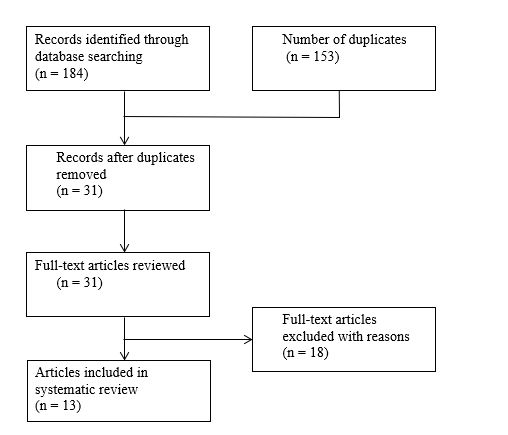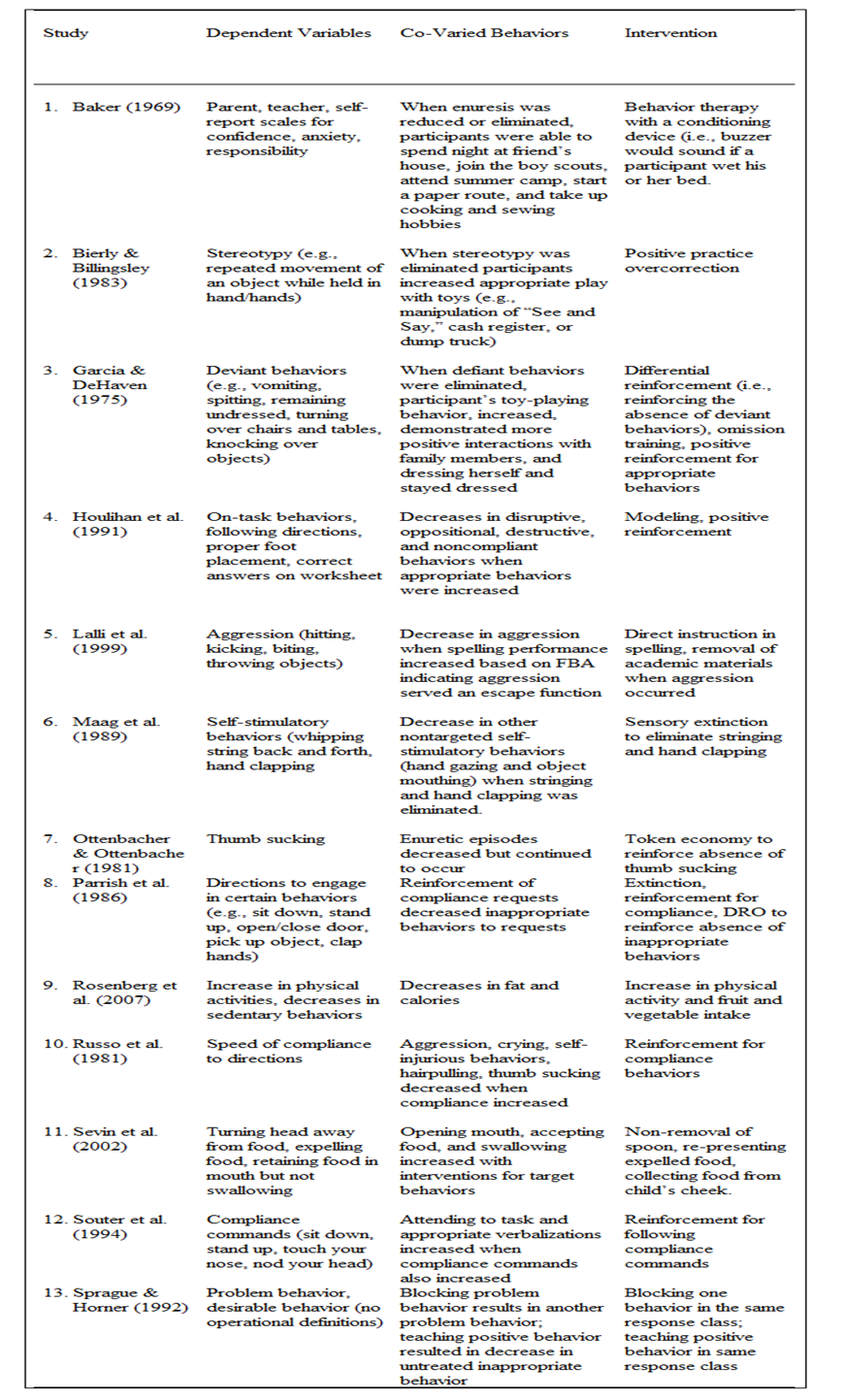AUCTORES
Globalize your Research
Review Article | DOI: https://doi.org/10.31579/2637-8892/178
*Department of Special Education and Communication Disorders, 202 Barkley Memorial Center, University of Nebraska-Lincoln, Lincoln, NE 68583 U.S.A.
*Corresponding Author: Department of Special Education and Communication Disorders, 202 Barkley Memorial Center, University of Nebraska-Lincoln, Lincoln, NE 68583 U.S.A. E-mail: [email protected]
Citation: John W. Maag (2022) Review of Response Covariation and Behavioral Interventions: Why It Occurs and How to Prevent It. J. Psychology and Mental Health Care, 6(5): DOI: 10.31579/2637-8892/178
Copyright: © 2022, John W. Maag, This is an open access article distributed under the Creative Commons Attribution License, which permits unrestricted use, distribution, and reproduction in any medium, provided the original work is properly cited.
Received: 01 July 2022 | Accepted: 05 July 2022 | Published: 12 July 2022
Keywords: response covariation; symptom substitution; behavioral intent; functional behavioral assessment; replacement behavior training
Response covariation is a term used by behaviorally-oriented psychologists to connotate when one aberrant behavior is suppressed or eliminated, another like behavior is displayed. Historically, psychotherapists—particularly those trained in traditional psychoanalysis—used the term symptom substitution to describe the same phenomenon. This singularity has been described for over 50 years under one of the two aforementioned terms. More recent research, regardless of the orientation, uses response covariation as the preferred and accepted term. Regardless of the term or psychological paradigm assigned to it, response covariation has been a vexing problem to both behavioral and psychoanalytic therapists as well as educators. The underlying issues are why response covariation occurs and how to avoid it during the therapeutic process. The purpose of this article is to review the research on this phenomenon, suggest a theoretical framework for both its occurrence and prevention by embedding strategies within any behavioral or psychoanalytic intervention.
Review of Response Covariation and Behavioral Interventions: Why
it Occurs and How to Prevent It.
Over 50 years ago Cahoon (1968) wrote an article describing “symptom substitution” and its relationship to behavior therapy. The thesis of his article was that psycho-dynamically oriented therapists would eliminate a patient’s distressing symptom (e.g., facial tic, feelings of anger or depression, compulsive behaviors) but by ignoring the underlying cause resulted in other new symptoms being displayed. Cahoon lamented that the term “symptom substitution” was used in an idiosyncratic, inferential way related to whatever school of therapy one ascribes rather than operationally defining the phenomenon in a way that was amenable to empirical research. The hypothesis he wanted to empirically investigate was whether certain types of therapies were more or less likely to result in symptom substitution. In retrospect, his premise was understandable 50 years ago but extremely limiting and no more empirically answerable than the prior theoretical idiocies about which he lamented.
The debate between psychodynamic and behavioral orientations continued into the 1970s. Nurnberger and Hingtgen (1973) reviewed studies at that time in an effort to establish whether or not symptom substitution had been empirically validated with enough data to justify questioning the treatment efficacy of behavioral approaches. They concluded that the occurrence of symptom substitution was extremely low when using behavioral interventions and, in fact, pointed out that behavioral interventions were so effective that they resulted in generalized improvement and expansion of the functional capacities of patients. They further indicated that symptom substitution was of minimal concern and that there were more important issues related to the success or failure of behavioral therapy.
Other researchers during the decades of the 1960s and 1970s discussed how many therapists lacked the awareness of behavioral principles and that interventions in which symptom substitution occurred were due to theoretical gaps in their knowledge. For example, Paul (1969) insisted that many patients had extensive gaps in their learning to display appropriate behaviors when the untoward behaviors were eliminated. Hence these patients presented with skill deficits that needed to be addressed in order to avoid symptom substitution. Wolpe (1969) posited that teaching prosocial behaviors required shaping and reinforcement to develop new routines while Bandura (1968) advised using modeling and systematic desensitization to avoid the emergence of other non-targeted inappropriate behaviors.
Research on the negative side effects of certain forms of punishment to treat behaviors and conditions such as pica, trichotillomania, stereotypy, and self-injurious behaviors started to appear in the late 1960s and 1970s that lead to a reexamination of what was called “response substitution.” Risley (1968) found that a topographically similar inappropriate behavior would increase when a target behavior was suppressed by punishment. He provided the example of a girl with autism who began climbing on a chair after she was punished for climbing on a bookcase. By the late 1970s researchers were beginning to describe more specific types of negative side effects associated with certain types of punishment such as brief contingent electric shock to sensitive parts of the body for engaging in self-injurious behaviors or squirting hot sauce or concentrated lemon juice into the mouth of a person engaging in pica (i.e., eating non-food stuffs).
Rutherford and Neel (1978) described seven negative side effects of punishment—the first being response substitution—an ironic pairing of the operant term “response” (i.e., behavior) to the psychodynamic term “substitution” rather than covariation. There is, however, another negative side effect which is particularly germane to the present discussion, and begins to pave the way for understanding why symptom substitution or the more commonly used term response covariation occurs. The negative side effect is punishment contrast. It is a phenomenon in which a behavior that is punished in one situation or setting increases above its baseline level in a different situation or setting where punishment is not administered (Maag, 2018). An analogy would be taking a recently opened bottle of champaign, placing a thumb over the top, and shaking. Nothing happens while a thumb is over the top, but once removed the champaign sprays out like a geyser. The reason is, of course, because of the pent up seltzer being unable to exit. Another example would be how certain individuals with Tourette’s disorder can sometimes suppress their tics for a period of time. However, eventually the tension mounts to the point where the tic escapes and is worse than it not being suppressed.
The two previous examples are only illustrative, but do not empirically explain why punishment contrast occurs. The reason for the occurrence of punishment contrast specifically, and response covariation in general, can be found in the roots of applied behavior analysis (ABA) first described by Baer et al. (1968) as a performance-based self-evaluative method for changing behavior. The theoretical and empirical precises of ABA resulted in researchers focusing on the purpose behavior serves. Almost ten years after the seminal article by Baer and colleagues was published, Carr (1977) described how self-injurious behaviors resulted from either positive reinforcement or negative reinforcement. During this time, Iwata et al. (1982) conducted what many consider the first study on functional behavioral assessment (FBA) which now refers to a series of heuristic approaches for determining the function individuals challenging behaviors serve. Put another way, all behavior serves some purpose—it is intentional and achieves some outcome or goal. Even reflexive behavior is purposeful. If someone abruptly claps their hands in front of an unknowing person’s face, that person will blink to preserve eyesight.
Neel and Cessna (1993) pithily stated that inappropriate behavior is nothing more than a deviant form of a nondeviant intent. They were referring the relation between the behavior exhibited and the outcome desired. When an individual acts, even with behaviors considered to be inappropriate, they do so to achieve some result. The desired result, or outcome, can be viewed as the intent or function of the behavior. In turn, the intent of the behavior will affect the form (i.e., appearance) the behavior takes to achieve a desired outcome. The function a behavior serves may be appropriate, but the form it takes may be inappropriate. For example, a student who makes animal noises may be doing so to obtain attention from his peers or to escape a task he perceives to be aversive. There is nothing inherently wrong with a student wanting attention from peers or escaping something perceived to be aversive. However, there are appropriate behaviors, through which, and times and situations in which, to obtain these outcomes.
Given this backdrop, the purpose of the present article is to review the theoretical and empirical literature on response covariation, determine if the function a behavior serves has previously been addressed in this context, and identify whether or not covaried behaviors served as dependent measures to be evaluated relative to the experimental variable (i.e., intervention). Finally, implications for clinicians and educators will be addressed that describe appropriate ways to embed strategies in interventions to decrease or eliminate untoward behaviors without someone experiencing a negative side effect of response covariation.
Prior to the method section, however, it is important to provide some context because this systematic review is rather unconventional. Typically, any narrative or meta-analytic review obtains studies for which certain dependent variables are assessed to determine the effectiveness of any given intervention. However, the topic of response covariation is rather unique because many of the “covaried” or “substituted” behaviors were not intentionally targeted as dependent variables. Rather some of the research studies reviewed here only described observing covaried or substituted behaviors without attempting any direct manipulation of them. Therefore, calculating traditional affect sizes (e.g., Cohen’s d or Hedges g) were not always possible. This situation may also explain why there has only been one cursory, descriptive literature review (versus systematic reviews) on response covariation (i.e., Nurnberger & Hingtgen, 1973) and also why many of the reviewed studies are decades old. Hence, the bulk of this review will consist of a systematic narrative description and analysis regarding response covariation.
A systematic search was performed to identify the extent research regarding the occurrence of response covariation or symptom substitution using primarily, but not limited to, behavioral interventions. The search methods were as consistent as possible with the 12-item PRISMA statement for reporting meta-analyses (Liberati et al., 2009). The purpose was to ensure as much clarity and transparency of conducting systematic reviews as possible given the uniqueness of the current topic. However, not all of the studies provided enough information to address the 12 PRISMA items.
Academic Search Premier was the search source with the following selected databases: ERIC, MedLINE, PsycARTICLES, and PsycINFO. Besides using Boolean terms/phrases (“response covariation”) AND (“children”) OR (“adolescents”) OR (“youth”) OR (“child”) OR (“teenagers”) OR (“students”) OR (“students with disabilities), the search also used four similar terms for response covariation (“response substitution”) OR (“behavior covariation”) OR (“behavior substitution”) OR (“symptom substitution).
Studies included were those published from 1968 when Cahoon’s article cited previously appeared that year in Psychological Bulletin. Studies had to be in English and published in peer-reviewed journals between January 1, 1968 and December 30, 2021. Participants considered in the present review were school-aged children from 6 years (kindergarten) to 18 years (12th grade) whose behavioral issues required intervention. All types of interventions/therapies were considered, but the majority of studies reviewed tended to be based on operant theory and techniques. Any non-intervention articles such as epidemiological studies (e.g., Arbeit et al., 2014) were excluded.
Studies were identified and retained at different stages based on PRISMA guidelines, and the results are displayed in Figure 1. There were a total of 184 entries under the following search terms: response covariation (n = 20), response substitution (n = 27), behavior covariation (n = 60), behavior substitution, (n = 27), symptom substitution, (n = 50). From that total, there were 153 entries that appeared more than once under a combination of the five search terms, leaving 31 articles that were read in their entirety, 18 of which were omitted for not meeting search criteria leaving a total of 13 articles to comprise this systematic review.

Seven study characteristics were coded for descriptive analysis. All studies were coded for participant characteristics and setting. Both targeted behaviors and covaried behaviors were identified, type of experimental design used, as well as intervention, and impact of intervention on covarying behaviors. Table 1 presents a summary of each study’s dependent variables, covaried behaviors, interventions implemented and their impact on the occurrence of increases or decreases in covaried behaviors. The experimenter initially coded all variables in Table 1. A graduate assistant coded the same variables for six randomly selected studies out of the 13 included in the present review. The interrater reliability between the two coders was 94.3% (agreements divided by agreements plus disagreements).
Descriptions of the types of designs and participants are presented narratively in the results. These variables were only coded by the experimenter since they were not appearing in Table 1 and, consequently, the graduate student was not instructed to code them, nor had expertise in determining the type of experimental design used for each study.

Type of Experimental Design
Two general types of experimental designs were use in the 13 studies reviewed: group designs and single case research designs. There were two studies using group designs. Baker (1969) used a control group pre-post design study. Rosenberg et al. (2007) used a more robust randomized controlled trial (RCT) group design. The remaining studies used some type of single case research design (SCRD).
In his introduction to evaluating the use of effect size calculations, Maag (2022) described Kazdin’s (2020) definition and appraisal of SCRD studies as experimental methods for determining effectiveness of an intervention (i.e., corrective action) for individual participants in a study. Kazdin further concluded that SCRDs enable researchers to draw empirically valid inferences and conclusions regarding treatment effects better than case studies. SRCDs have been used with various populations in a range of settings including, but not limited to, hospitals, residential facilities, out-patience clinics, schools, and in the workplace (e.g., Kratochwil & Levin, 2014). Kazdin believed the term single-case can be misconstrued to mean restricted to one individual whereas SCRDs can be applied to large groups such as all students in a classroom (e.g., McNiff et al., 2019), although their primary concern focuses at the individual level. There are four commonly accepted SCRDs that can establish experimental control and account for confounding variables: reversal design, multiple baseline design, changing conditions design (a variation of the reversal design), and alternating treatments design (Maag, 2018). The simple AB design which consists of only two phases—baseline (A) and intervention (B)—is unable to establish experimental control nor account for extraneous or confounding variables.
Two of the 11 SCRD studies used only an AB design (Garica & DeHaven, 1975; Ottenbacher & Ottenbacher, 1981). Therefore, results of these two studies are equivocal because of the two serious design flaws inherent in the AB design described previously. The most commonly used SCRD was the reversal design (n = 6). Only one study used a multiple baseline design (Russo et al., 1981). The remaining two studies used a changing conditions design (Houlihan et al., 1991; Sevin et al., 2002) which is used to determine the effectiveness of two or more interventions on a target behavior. Sometimes this technique is called an ABC design in which A refers to the baseline, B refers to the first intervention, and C designates the application of a second intervention. As is the case with an AB design, a functional relation between a target behavior and intervention cannot be determined unless there is a return-to-baseline phase between the two different intervention phases. In the present review, both Houlihan et al. and Sevin et al. studies included another baseline phase before implementing the second intervention, hence establishing experimental control.
There were understandably more participants in the two group design studies. There were 90 elementary school participants in the Baker (1969) study, 30 with enuresis and 60 controls. The RCT conducted by Rosenberg et al. (2007) had 878 adolescents with a mean age of 12.7 years. Although both studies had enough participants to have sufficient statistical power, nether described much detail about their characteristics. For example, the only additional information Baker provided was that the enuretic group consistent of 20 males and 10 females whose ages ranged from six to 12 years old. No information was provided regarding the 60 participants in the control group. Rosenberg and colleagues provided the age range of their participants to be between 10 to 15 years old, with 54
Dependent variables, co-varied behaviors, and interventions for each study are presented in Table 1. Dependent variables for the two group design studies were rather different than for those using SCRDs. For example, Baker (1969) used parent, teacher, and self-report rating scales for measuring participants’ confidence, anxiety, and responsibility for both pre- and post-treatment of behavioral therapy for enuresis. In the case of the other group design study, Rosenberg et al. (2007) used the University of Minnesota Data System to estimate dietary nutrient intake (e.g., total daily kilocalories, total calories from fat, total grams of fiber, and servings per day of fruit and vegetables).
Dependent variables for the 11 SRCD studies were much more specific and amounted to operationally targeted behaviors. For example, Bierly and Billingsley (1983) defined stereotypy as repeated movement of an object when held in hand(s) while Garcia and DeHaven (1975) defined deviant behaviors as vomiting, spitting, remining undressed, turning over chairs and tables, and knocking over objects. Similarly operationally defined target behaviors were provided for four more studies as well (Lalli et al, 1999; Maag et al., 1986; Ottenbacher & Ottenbacher, 1981; Sevin et al., 2002). Two studies simply had lists of compliance commands such as “sit down,” “touch your nose,” or “nod your head” (Parrish et al., 1986; Souter et al., 1994). Another three studies did not operationally define all their target behaviors and instead used terms such as “on-task,” “compliance to directions,” or “problem behavior” (Houlihan et al., 1991; Russo et al., 1981; Sprague & Horner, 1992). Finally, some studies targeted behaviors to increase (Houlihan et al., 1991; Parrish et al., 1986; Russo et al., 1981; Souter et al., 1994) while the others had behaviors to decrease with the corollary covaried behaviors.
Results of both covaried behaviors and interventions for the dependent variables are presented together in order to provide continuity and the relationship to each other. There were three studies, however, in which interventions were provided both for the dependent variables and covaried behaviors (Garcia & DeHaven, 1975; Parrish et al., 1986; Russo et al., 1981) which presents a confound for determining whether interventions for the dependent variables actually changed covaried behaviors in isolation. Table 1 also provides a summary of the interaction between dependent variables, covaried behaviors, and interventions.
Two studies found that when stereotypy and deviant behaviors were eliminated participants engaged in much more toy-playing and positive interactions with family members (Bierly & Billingsley, 1983; Garcia & DeHaven, 1975). One study used a direct instruction intervention to improve participants’ spelling scores which reduced aggressive behaviors (e.g., hitting, kicking, biting, throwing objects) which the researchers believed were initially performed as a way to escape spelling tasks for which they did not possess the requisite skills (Lalli et al., 1999). Coincidentally, the Lalli and colleagues’ study was the only one to conduct a functional behavioral assessment to determine the purpose targeted behaviors served. Maag et al. (1986) used a more novel intervention, sensory extinction, to eliminate two self-stimulatory behaviors—hand clapping and repetitive up and down motions with a piece of string (i.e., “stringing”). Their hypothesis was that kinesthetic sense modality provided reinforcement for those two behaviors and when that reinforcement was eliminated, the behaviors were extinguished. Interestingly, two covaried behaviors also decreased—hand gazing and object mouthing. Hand clapping and hand gazing shared the same topography but not the same sensory reinforcement function.
Symptom substitution, the psychodynamic term, and response covariation, the operant somewhat equivalent idiom were highly debated and researched during the lasty three decades of the 20th century. The debate was initially framed, at least by behaviorists, as one between objectivity and subjectivity. Operant theorists and behavior therapists believed that “symptom substitution” was too vague an expression to be researched empirically (Cahoon, 1968). A more detailed and historical description of this debate was provided in the introduction of this article. A modicum of research was conducted on response covariation, the more commonly accepted term, during and up until the early part of the 21st century. Then that phenomenon gradually faded from both research and theory. The purpose of the current article was to review the empirical literature on response covariation and by doing so draw conclusions regarding it as a behavioral phenomenon, suggest why it occurs, and how to prevent it. This task proved to be daunting considering only 13 studies were found to be eligible for review with the most recent (e.g., Rosenberg et al., 2007) being 15 years old. Further, it was surprising that no systematic review had previously been conducted on this topic—excluding one dated selective, literature review (e.g., Nurnberger & Hingtgen, 1973). Response covariation as a topic of study seemingly vanished. Therefore, the remainder of this article will first review the results and provide a detailed account of why response covariation occurs and how to prevent it.
Results of the 13 studies reviewed can be summarized as follows. First, only two group design studies have been conducted on response covariation (e.g., Baker, 1969; Rosenberg et al., 2007). The remaining 11 studies all used single case research designs (SCRDs), which should not come as a surprise since the term response covariation comes from an operant orientation. Second, results need to be interpreted cautiously since several studies reviewed not only provided intervention to change dependent variables but also addressed the covaried behaviors, treating them more as a separate dependent variable than arising from the initial intervention. Third, there were some peculiarities regarding the suppression of some inappropriate behaviors and the unintended suppression of other non-treated behaviors. For example, Maag et al. (1986) found that when hand clapping was suppressed, the covaried non-targeted behavior of hand gazing also decreased. One explanation could be the generalized suppression was due to both behaviors being members of the same response class in terms of topography. However, they did not appear to serve the same purpose even though a formal functional behavioral assessment (FBA) was not conducted. Specifically, hand clapping seemed to be maintain by the kinesthetic sensory reinforcement that was extinguished whereas hand gazing, that did not involve any motion nor generate any tactile stimulation, also decreased. The reason for this seemingly unrelated behavior remains speculative and unconvincing.
The reason for response covariation, or at least the phenomenon of when one inappropriate behavior is suppressed another inappropriate behavior is displayed, can be explained through a series of heuristic approaches for determining the function individuals challenging behaviors serve—that is, by conducting a functional behavioral assessment (FBA). The focus on FBAs began in the early 1980s and literally hundreds if not over a thousand studies have been conducted on various aspects and populations using FBAs. There have also been approximately 17 systematic reviews—both meta-analytic and narrative—that have appeared in the literature from the 1980s through the present (e.g., Maag, 2019). The previous discussion of negative side effects of punishment, such as response substitution and punishment contrast, demonstrates the problem created when the function a target behavior to decrease is not directly addressed prior to a suppressive technique being applied (Maag, 2018).
A study conducted by Ayllon (1963) almost 60 years ago illustrates this point. He used a behavioral technique called stimulus satiation to treat a hospitalized female psychiatric patient who hoarded and stored large numbers of towels in her room. Stimulus satiation is similar to negative practice or “ordeal therapy” but instead of repeatedly performing the negative behavior, the focus is on exposing an individual to the antecedents of their behavior—in this specific case, hoarding towels. The treatment consisted of having the nurses go into the patient’s room and, without comment, hand her an ever-increasing number of towels. The first week nurses handed her an average of seven towels, and the number was increased to 60 towels by the third week. After accumulating over 600 towels, the patient began taking a few out of her room. At that point, no more towels were handed to her.
Ayllon (1963) was able to decease towel hoarding. However, what he did not address was that the behavior of hoarding towels served some purpose for the patient—such as obtaining attention or being empowered by refusing to follow hospital protocol. Therefore, because the function of towel hoarding was not addressed, it was likely that another inappropriate behavior that served the same purpose would subsequently be displayed. The operant technique stimulus satiation has other names depending on a therapist’s theoretical orientation—pattern reversal, inconvenience, or paradoxical directives. The point is that without assessing and addressing the function any inappropriate behavior serves response covariation will likely occur so that the individual can continue to obtain a desired outcome.
Not every study reviewed resulted in another negative behavior being performed when the target inappropriate behavior was decreased. Bierly and Billingsley (1983) found that when stereotypy was decreased, appropriate play with toys increased. Houlihan et al. (1991) increased on-task behaviors and following instructions and observed decreases in disruptive and noncompliant behaviors. Two other studies that increased participants compliance with directions found, in one case, that aggression and self-injurious behaviors decreased (Russo et al., 1981) while Souter et al. (1994) found covaried increases in on-task behaviors and appropriate verbalizations. These positive changes in covaried behaviors that did not receive intervention is easy to explain. For example, increases in the covaried behavior of playing with toys occurred because participants were no longer spending timer engaging in self-stimulatory behaviors. The same can be said when on-task behaviors and following directions increased, the covaried behaviors of disruption and opposition decreased. The reason is that if students were engaging in the inappropriate covaried behaviors, then an increase in compliance to stop performing them would occur. By reinforcing compliance to directions that involved stopping inappropriate behavior also resulted in both targeted and covaried behaviors being reinforced.
Covariation can sometimes result in a positive side effect of certain behaviors receiving intervention (e.g., increases in appropriate behavior resulting from decreases in inappropriate behavior). The reasons for those positive changes were discussed previously. However, a more problematic effect is when decreases in certain targeted inappropriate behaviors result in increases in other non-targeted inappropriate behaviors. The reason for this occurrence was due to the covaried behavior being performed in order for an individual to achieve the same goal (i.e., purpose) as the eliminated inappropriate target behavior. The solution to this problem is to identify and teach individuals replacement behaviors as part of any intervention to eliminate negative behaviors.
A replacement behavior refers to an appropriate behavior that serves the same purpose as the inappropriate behavior. Maag and Kemp (2003) described how generating replacement behaviors begins with identifying a response class. A response class is a group of behaviors that either share the same topography, effects of reinforcement and punishment, or serve the same function (Malott et al., 2000). For example, a child with a developmental disability who bangs her head into peers as a way to escape close physical proximity may be taught the replacement behavior of extending her arm with palm up in a manner similar to a police officer directing traffic to stop. The inappropriate behavior and replacement behavior share the same topography: body part (head vs. arm and hand), movement (forward), and function (escape). Maag and Kemp indicated that replacement behaviors that share the same topography as the inappropriate behavior are more likely to be accepted and used by a child.
A list of replacement behaviors are next generated in a way similar to identifying effective reinforcers: high status youngsters are observed to determine what behaviors they use to obtain desired outcomes, youngsters themselves are asked what they would like to try, and significant adults (e.g., teachers, coaches, parents) are asked to list behaviors they have observed youngsters use to get what they want, if not appropriately, then at least without resulting in disciplinary action. A list is created from each source and the target youngster rank orders them to determine the most desirable. Next, individual-specific deficiencies are assessed to determine what training, if any, is required—behavioral, cognitive, or self-control. Finally, a reinforcement program is developed to motivate the target child to use the replacement behaviors. Eventually, the repeated use of the replacement behavior will become self-reinforcing—because it gets the child what she wants—and the external reinforcement program can then be faded.
There are two limitations to the current review that need to be acknowledged and addressed. First, most of the studies reviewed were quite dated. Therefore, they may not represent more current studies that would use terms other than those related to response covariation. Although it is possible that some studies exist in dissertations or those appearing in book chapters, the likelihood seems quite low. The reason is because nomenclature has not changed during the last decade from response covariation to some other novel term. Second, no effect sizes were calculated. There are effect size formulas for SCRD studies, the most common being nonoverlap methods (Maag, 2022). However, most SCRD effect size calculations can demonstrate an intervention’s effectiveness but not the magnitude of such changes. Further, many studies reviewed did not use covaried behaviors as a dependent variable. Consequently, there were few graphs having a baseline and covaried behavior phase adjacent to each other which is required to compute SCRD effect sizes.
A systematic review of the literature on response covariation reveals, at least implicitly, how it occurs and how to avoid it. It occurs when the function of any dependent variable, or target behavior, is not first determined through FBAs. In the current review only one study explicitly determined the function of target behaviors (Lalli et al., 1999) while another informally determined the function by hypothesizing what sensory modality was reinforcing their occurrence (Maag et al., 1986). The solution to preventing response covariation—at least when one negative behavior appears when another is suppressed—is to teach individuals and reinforce their use of an appropriate behavior that serves the same purpose. The idea of teaching replacement behaviors was hinted at indirectly very early in the literature on response covariation when Paul (1969) stated how many individuals do not possess the necessary skills in their repertoire to perform appropriate behaviors when an inappropriate behavior is suppressed. Wolpe (1969) suggested teaching individuals prosocial behaviors through shaping and reinforcement while Bandura (1968) advised using modeling and systematic desensitization to avoid the emergence of other non-targeted inappropriate behaviors. Yet, it took another 20 years before the process was formalized and empirically validated for using FBAs to determine replacement behaviors. However, the techniques described by Wolpe and Bandura decades ago are nevertheless foundational today for teaching replacement behaviors. Finally, two limitations to the current review were presented—outdated studies and lack of calculating effect sizes. Nevertheless, it appears that interest in the parameters and impact surrounding response covariation has waned throughout the last decade. Yet it remains quite germane for clinicians who conduct psychotherapy using various modalties.
Clearly Auctoresonline and particularly Psychology and Mental Health Care Journal is dedicated to improving health care services for individuals and populations. The editorial boards' ability to efficiently recognize and share the global importance of health literacy with a variety of stakeholders. Auctoresonline publishing platform can be used to facilitate of optimal client-based services and should be added to health care professionals' repertoire of evidence-based health care resources.

Journal of Clinical Cardiology and Cardiovascular Intervention The submission and review process was adequate. However I think that the publication total value should have been enlightened in early fases. Thank you for all.

Journal of Women Health Care and Issues By the present mail, I want to say thank to you and tour colleagues for facilitating my published article. Specially thank you for the peer review process, support from the editorial office. I appreciate positively the quality of your journal.
Journal of Clinical Research and Reports I would be very delighted to submit my testimonial regarding the reviewer board and the editorial office. The reviewer board were accurate and helpful regarding any modifications for my manuscript. And the editorial office were very helpful and supportive in contacting and monitoring with any update and offering help. It was my pleasure to contribute with your promising Journal and I am looking forward for more collaboration.

We would like to thank the Journal of Thoracic Disease and Cardiothoracic Surgery because of the services they provided us for our articles. The peer-review process was done in a very excellent time manner, and the opinions of the reviewers helped us to improve our manuscript further. The editorial office had an outstanding correspondence with us and guided us in many ways. During a hard time of the pandemic that is affecting every one of us tremendously, the editorial office helped us make everything easier for publishing scientific work. Hope for a more scientific relationship with your Journal.

The peer-review process which consisted high quality queries on the paper. I did answer six reviewers’ questions and comments before the paper was accepted. The support from the editorial office is excellent.

Journal of Neuroscience and Neurological Surgery. I had the experience of publishing a research article recently. The whole process was simple from submission to publication. The reviewers made specific and valuable recommendations and corrections that improved the quality of my publication. I strongly recommend this Journal.

Dr. Katarzyna Byczkowska My testimonial covering: "The peer review process is quick and effective. The support from the editorial office is very professional and friendly. Quality of the Clinical Cardiology and Cardiovascular Interventions is scientific and publishes ground-breaking research on cardiology that is useful for other professionals in the field.

Thank you most sincerely, with regard to the support you have given in relation to the reviewing process and the processing of my article entitled "Large Cell Neuroendocrine Carcinoma of The Prostate Gland: A Review and Update" for publication in your esteemed Journal, Journal of Cancer Research and Cellular Therapeutics". The editorial team has been very supportive.

Testimony of Journal of Clinical Otorhinolaryngology: work with your Reviews has been a educational and constructive experience. The editorial office were very helpful and supportive. It was a pleasure to contribute to your Journal.

Dr. Bernard Terkimbi Utoo, I am happy to publish my scientific work in Journal of Women Health Care and Issues (JWHCI). The manuscript submission was seamless and peer review process was top notch. I was amazed that 4 reviewers worked on the manuscript which made it a highly technical, standard and excellent quality paper. I appreciate the format and consideration for the APC as well as the speed of publication. It is my pleasure to continue with this scientific relationship with the esteem JWHCI.

This is an acknowledgment for peer reviewers, editorial board of Journal of Clinical Research and Reports. They show a lot of consideration for us as publishers for our research article “Evaluation of the different factors associated with side effects of COVID-19 vaccination on medical students, Mutah university, Al-Karak, Jordan”, in a very professional and easy way. This journal is one of outstanding medical journal.
Dear Hao Jiang, to Journal of Nutrition and Food Processing We greatly appreciate the efficient, professional and rapid processing of our paper by your team. If there is anything else we should do, please do not hesitate to let us know. On behalf of my co-authors, we would like to express our great appreciation to editor and reviewers.

As an author who has recently published in the journal "Brain and Neurological Disorders". I am delighted to provide a testimonial on the peer review process, editorial office support, and the overall quality of the journal. The peer review process at Brain and Neurological Disorders is rigorous and meticulous, ensuring that only high-quality, evidence-based research is published. The reviewers are experts in their fields, and their comments and suggestions were constructive and helped improve the quality of my manuscript. The review process was timely and efficient, with clear communication from the editorial office at each stage. The support from the editorial office was exceptional throughout the entire process. The editorial staff was responsive, professional, and always willing to help. They provided valuable guidance on formatting, structure, and ethical considerations, making the submission process seamless. Moreover, they kept me informed about the status of my manuscript and provided timely updates, which made the process less stressful. The journal Brain and Neurological Disorders is of the highest quality, with a strong focus on publishing cutting-edge research in the field of neurology. The articles published in this journal are well-researched, rigorously peer-reviewed, and written by experts in the field. The journal maintains high standards, ensuring that readers are provided with the most up-to-date and reliable information on brain and neurological disorders. In conclusion, I had a wonderful experience publishing in Brain and Neurological Disorders. The peer review process was thorough, the editorial office provided exceptional support, and the journal's quality is second to none. I would highly recommend this journal to any researcher working in the field of neurology and brain disorders.

Dear Agrippa Hilda, Journal of Neuroscience and Neurological Surgery, Editorial Coordinator, I trust this message finds you well. I want to extend my appreciation for considering my article for publication in your esteemed journal. I am pleased to provide a testimonial regarding the peer review process and the support received from your editorial office. The peer review process for my paper was carried out in a highly professional and thorough manner. The feedback and comments provided by the authors were constructive and very useful in improving the quality of the manuscript. This rigorous assessment process undoubtedly contributes to the high standards maintained by your journal.

International Journal of Clinical Case Reports and Reviews. I strongly recommend to consider submitting your work to this high-quality journal. The support and availability of the Editorial staff is outstanding and the review process was both efficient and rigorous.

Thank you very much for publishing my Research Article titled “Comparing Treatment Outcome Of Allergic Rhinitis Patients After Using Fluticasone Nasal Spray And Nasal Douching" in the Journal of Clinical Otorhinolaryngology. As Medical Professionals we are immensely benefited from study of various informative Articles and Papers published in this high quality Journal. I look forward to enriching my knowledge by regular study of the Journal and contribute my future work in the field of ENT through the Journal for use by the medical fraternity. The support from the Editorial office was excellent and very prompt. I also welcome the comments received from the readers of my Research Article.

Dear Erica Kelsey, Editorial Coordinator of Cancer Research and Cellular Therapeutics Our team is very satisfied with the processing of our paper by your journal. That was fast, efficient, rigorous, but without unnecessary complications. We appreciated the very short time between the submission of the paper and its publication on line on your site.

I am very glad to say that the peer review process is very successful and fast and support from the Editorial Office. Therefore, I would like to continue our scientific relationship for a long time. And I especially thank you for your kindly attention towards my article. Have a good day!

"We recently published an article entitled “Influence of beta-Cyclodextrins upon the Degradation of Carbofuran Derivatives under Alkaline Conditions" in the Journal of “Pesticides and Biofertilizers” to show that the cyclodextrins protect the carbamates increasing their half-life time in the presence of basic conditions This will be very helpful to understand carbofuran behaviour in the analytical, agro-environmental and food areas. We greatly appreciated the interaction with the editor and the editorial team; we were particularly well accompanied during the course of the revision process, since all various steps towards publication were short and without delay".

I would like to express my gratitude towards you process of article review and submission. I found this to be very fair and expedient. Your follow up has been excellent. I have many publications in national and international journal and your process has been one of the best so far. Keep up the great work.

We are grateful for this opportunity to provide a glowing recommendation to the Journal of Psychiatry and Psychotherapy. We found that the editorial team were very supportive, helpful, kept us abreast of timelines and over all very professional in nature. The peer review process was rigorous, efficient and constructive that really enhanced our article submission. The experience with this journal remains one of our best ever and we look forward to providing future submissions in the near future.

I am very pleased to serve as EBM of the journal, I hope many years of my experience in stem cells can help the journal from one way or another. As we know, stem cells hold great potential for regenerative medicine, which are mostly used to promote the repair response of diseased, dysfunctional or injured tissue using stem cells or their derivatives. I think Stem Cell Research and Therapeutics International is a great platform to publish and share the understanding towards the biology and translational or clinical application of stem cells.

I would like to give my testimony in the support I have got by the peer review process and to support the editorial office where they were of asset to support young author like me to be encouraged to publish their work in your respected journal and globalize and share knowledge across the globe. I really give my great gratitude to your journal and the peer review including the editorial office.

I am delighted to publish our manuscript entitled "A Perspective on Cocaine Induced Stroke - Its Mechanisms and Management" in the Journal of Neuroscience and Neurological Surgery. The peer review process, support from the editorial office, and quality of the journal are excellent. The manuscripts published are of high quality and of excellent scientific value. I recommend this journal very much to colleagues.

Dr.Tania Muñoz, My experience as researcher and author of a review article in The Journal Clinical Cardiology and Interventions has been very enriching and stimulating. The editorial team is excellent, performs its work with absolute responsibility and delivery. They are proactive, dynamic and receptive to all proposals. Supporting at all times the vast universe of authors who choose them as an option for publication. The team of review specialists, members of the editorial board, are brilliant professionals, with remarkable performance in medical research and scientific methodology. Together they form a frontline team that consolidates the JCCI as a magnificent option for the publication and review of high-level medical articles and broad collective interest. I am honored to be able to share my review article and open to receive all your comments.

“The peer review process of JPMHC is quick and effective. Authors are benefited by good and professional reviewers with huge experience in the field of psychology and mental health. The support from the editorial office is very professional. People to contact to are friendly and happy to help and assist any query authors might have. Quality of the Journal is scientific and publishes ground-breaking research on mental health that is useful for other professionals in the field”.

Dear editorial department: On behalf of our team, I hereby certify the reliability and superiority of the International Journal of Clinical Case Reports and Reviews in the peer review process, editorial support, and journal quality. Firstly, the peer review process of the International Journal of Clinical Case Reports and Reviews is rigorous, fair, transparent, fast, and of high quality. The editorial department invites experts from relevant fields as anonymous reviewers to review all submitted manuscripts. These experts have rich academic backgrounds and experience, and can accurately evaluate the academic quality, originality, and suitability of manuscripts. The editorial department is committed to ensuring the rigor of the peer review process, while also making every effort to ensure a fast review cycle to meet the needs of authors and the academic community. Secondly, the editorial team of the International Journal of Clinical Case Reports and Reviews is composed of a group of senior scholars and professionals with rich experience and professional knowledge in related fields. The editorial department is committed to assisting authors in improving their manuscripts, ensuring their academic accuracy, clarity, and completeness. Editors actively collaborate with authors, providing useful suggestions and feedback to promote the improvement and development of the manuscript. We believe that the support of the editorial department is one of the key factors in ensuring the quality of the journal. Finally, the International Journal of Clinical Case Reports and Reviews is renowned for its high- quality articles and strict academic standards. The editorial department is committed to publishing innovative and academically valuable research results to promote the development and progress of related fields. The International Journal of Clinical Case Reports and Reviews is reasonably priced and ensures excellent service and quality ratio, allowing authors to obtain high-level academic publishing opportunities in an affordable manner. I hereby solemnly declare that the International Journal of Clinical Case Reports and Reviews has a high level of credibility and superiority in terms of peer review process, editorial support, reasonable fees, and journal quality. Sincerely, Rui Tao.

Clinical Cardiology and Cardiovascular Interventions I testity the covering of the peer review process, support from the editorial office, and quality of the journal.

Clinical Cardiology and Cardiovascular Interventions, we deeply appreciate the interest shown in our work and its publication. It has been a true pleasure to collaborate with you. The peer review process, as well as the support provided by the editorial office, have been exceptional, and the quality of the journal is very high, which was a determining factor in our decision to publish with you.
The peer reviewers process is quick and effective, the supports from editorial office is excellent, the quality of journal is high. I would like to collabroate with Internatioanl journal of Clinical Case Reports and Reviews journal clinically in the future time.

Clinical Cardiology and Cardiovascular Interventions, I would like to express my sincerest gratitude for the trust placed in our team for the publication in your journal. It has been a true pleasure to collaborate with you on this project. I am pleased to inform you that both the peer review process and the attention from the editorial coordination have been excellent. Your team has worked with dedication and professionalism to ensure that your publication meets the highest standards of quality. We are confident that this collaboration will result in mutual success, and we are eager to see the fruits of this shared effort.

Dear Dr. Jessica Magne, Editorial Coordinator 0f Clinical Cardiology and Cardiovascular Interventions, I hope this message finds you well. I want to express my utmost gratitude for your excellent work and for the dedication and speed in the publication process of my article titled "Navigating Innovation: Qualitative Insights on Using Technology for Health Education in Acute Coronary Syndrome Patients." I am very satisfied with the peer review process, the support from the editorial office, and the quality of the journal. I hope we can maintain our scientific relationship in the long term.
Dear Monica Gissare, - Editorial Coordinator of Nutrition and Food Processing. ¨My testimony with you is truly professional, with a positive response regarding the follow-up of the article and its review, you took into account my qualities and the importance of the topic¨.

Dear Dr. Jessica Magne, Editorial Coordinator 0f Clinical Cardiology and Cardiovascular Interventions, The review process for the article “The Handling of Anti-aggregants and Anticoagulants in the Oncologic Heart Patient Submitted to Surgery” was extremely rigorous and detailed. From the initial submission to the final acceptance, the editorial team at the “Journal of Clinical Cardiology and Cardiovascular Interventions” demonstrated a high level of professionalism and dedication. The reviewers provided constructive and detailed feedback, which was essential for improving the quality of our work. Communication was always clear and efficient, ensuring that all our questions were promptly addressed. The quality of the “Journal of Clinical Cardiology and Cardiovascular Interventions” is undeniable. It is a peer-reviewed, open-access publication dedicated exclusively to disseminating high-quality research in the field of clinical cardiology and cardiovascular interventions. The journal's impact factor is currently under evaluation, and it is indexed in reputable databases, which further reinforces its credibility and relevance in the scientific field. I highly recommend this journal to researchers looking for a reputable platform to publish their studies.

Dear Editorial Coordinator of the Journal of Nutrition and Food Processing! "I would like to thank the Journal of Nutrition and Food Processing for including and publishing my article. The peer review process was very quick, movement and precise. The Editorial Board has done an extremely conscientious job with much help, valuable comments and advices. I find the journal very valuable from a professional point of view, thank you very much for allowing me to be part of it and I would like to participate in the future!”

Dealing with The Journal of Neurology and Neurological Surgery was very smooth and comprehensive. The office staff took time to address my needs and the response from editors and the office was prompt and fair. I certainly hope to publish with this journal again.Their professionalism is apparent and more than satisfactory. Susan Weiner

My Testimonial Covering as fellowing: Lin-Show Chin. The peer reviewers process is quick and effective, the supports from editorial office is excellent, the quality of journal is high. I would like to collabroate with Internatioanl journal of Clinical Case Reports and Reviews.

My experience publishing in Psychology and Mental Health Care was exceptional. The peer review process was rigorous and constructive, with reviewers providing valuable insights that helped enhance the quality of our work. The editorial team was highly supportive and responsive, making the submission process smooth and efficient. The journal's commitment to high standards and academic rigor makes it a respected platform for quality research. I am grateful for the opportunity to publish in such a reputable journal.
My experience publishing in International Journal of Clinical Case Reports and Reviews was exceptional. I Come forth to Provide a Testimonial Covering the Peer Review Process and the editorial office for the Professional and Impartial Evaluation of the Manuscript.

I would like to offer my testimony in the support. I have received through the peer review process and support the editorial office where they are to support young authors like me, encourage them to publish their work in your esteemed journals, and globalize and share knowledge globally. I really appreciate your journal, peer review, and editorial office.
Dear Agrippa Hilda- Editorial Coordinator of Journal of Neuroscience and Neurological Surgery, "The peer review process was very quick and of high quality, which can also be seen in the articles in the journal. The collaboration with the editorial office was very good."

I would like to express my sincere gratitude for the support and efficiency provided by the editorial office throughout the publication process of my article, “Delayed Vulvar Metastases from Rectal Carcinoma: A Case Report.” I greatly appreciate the assistance and guidance I received from your team, which made the entire process smooth and efficient. The peer review process was thorough and constructive, contributing to the overall quality of the final article. I am very grateful for the high level of professionalism and commitment shown by the editorial staff, and I look forward to maintaining a long-term collaboration with the International Journal of Clinical Case Reports and Reviews.
To Dear Erin Aust, I would like to express my heartfelt appreciation for the opportunity to have my work published in this esteemed journal. The entire publication process was smooth and well-organized, and I am extremely satisfied with the final result. The Editorial Team demonstrated the utmost professionalism, providing prompt and insightful feedback throughout the review process. Their clear communication and constructive suggestions were invaluable in enhancing my manuscript, and their meticulous attention to detail and dedication to quality are truly commendable. Additionally, the support from the Editorial Office was exceptional. From the initial submission to the final publication, I was guided through every step of the process with great care and professionalism. The team's responsiveness and assistance made the entire experience both easy and stress-free. I am also deeply impressed by the quality and reputation of the journal. It is an honor to have my research featured in such a respected publication, and I am confident that it will make a meaningful contribution to the field.

"I am grateful for the opportunity of contributing to [International Journal of Clinical Case Reports and Reviews] and for the rigorous review process that enhances the quality of research published in your esteemed journal. I sincerely appreciate the time and effort of your team who have dedicatedly helped me in improvising changes and modifying my manuscript. The insightful comments and constructive feedback provided have been invaluable in refining and strengthening my work".

I thank the ‘Journal of Clinical Research and Reports’ for accepting this article for publication. This is a rigorously peer reviewed journal which is on all major global scientific data bases. I note the review process was prompt, thorough and professionally critical. It gave us an insight into a number of important scientific/statistical issues. The review prompted us to review the relevant literature again and look at the limitations of the study. The peer reviewers were open, clear in the instructions and the editorial team was very prompt in their communication. This journal certainly publishes quality research articles. I would recommend the journal for any future publications.

Dear Jessica Magne, with gratitude for the joint work. Fast process of receiving and processing the submitted scientific materials in “Clinical Cardiology and Cardiovascular Interventions”. High level of competence of the editors with clear and correct recommendations and ideas for enriching the article.

We found the peer review process quick and positive in its input. The support from the editorial officer has been very agile, always with the intention of improving the article and taking into account our subsequent corrections.

My article, titled 'No Way Out of the Smartphone Epidemic Without Considering the Insights of Brain Research,' has been republished in the International Journal of Clinical Case Reports and Reviews. The review process was seamless and professional, with the editors being both friendly and supportive. I am deeply grateful for their efforts.
To Dear Erin Aust – Editorial Coordinator of Journal of General Medicine and Clinical Practice! I declare that I am absolutely satisfied with your work carried out with great competence in following the manuscript during the various stages from its receipt, during the revision process to the final acceptance for publication. Thank Prof. Elvira Farina

Dear Jessica, and the super professional team of the ‘Clinical Cardiology and Cardiovascular Interventions’ I am sincerely grateful to the coordinated work of the journal team for the no problem with the submission of my manuscript: “Cardiometabolic Disorders in A Pregnant Woman with Severe Preeclampsia on the Background of Morbid Obesity (Case Report).” The review process by 5 experts was fast, and the comments were professional, which made it more specific and academic, and the process of publication and presentation of the article was excellent. I recommend that my colleagues publish articles in this journal, and I am interested in further scientific cooperation. Sincerely and best wishes, Dr. Oleg Golyanovskiy.

Dear Ashley Rosa, Editorial Coordinator of the journal - Psychology and Mental Health Care. " The process of obtaining publication of my article in the Psychology and Mental Health Journal was positive in all areas. The peer review process resulted in a number of valuable comments, the editorial process was collaborative and timely, and the quality of this journal has been quickly noticed, resulting in alternative journals contacting me to publish with them." Warm regards, Susan Anne Smith, PhD. Australian Breastfeeding Association.

Dear Jessica Magne, Editorial Coordinator, Clinical Cardiology and Cardiovascular Interventions, Auctores Publishing LLC. I appreciate the journal (JCCI) editorial office support, the entire team leads were always ready to help, not only on technical front but also on thorough process. Also, I should thank dear reviewers’ attention to detail and creative approach to teach me and bring new insights by their comments. Surely, more discussions and introduction of other hemodynamic devices would provide better prevention and management of shock states. Your efforts and dedication in presenting educational materials in this journal are commendable. Best wishes from, Farahnaz Fallahian.
Dear Maria Emerson, Editorial Coordinator, International Journal of Clinical Case Reports and Reviews, Auctores Publishing LLC. I am delighted to have published our manuscript, "Acute Colonic Pseudo-Obstruction (ACPO): A rare but serious complication following caesarean section." I want to thank the editorial team, especially Maria Emerson, for their prompt review of the manuscript, quick responses to queries, and overall support. Yours sincerely Dr. Victor Olagundoye.

Dear Ashley Rosa, Editorial Coordinator, International Journal of Clinical Case Reports and Reviews. Many thanks for publishing this manuscript after I lost confidence the editors were most helpful, more than other journals Best wishes from, Susan Anne Smith, PhD. Australian Breastfeeding Association.

Dear Agrippa Hilda, Editorial Coordinator, Journal of Neuroscience and Neurological Surgery. The entire process including article submission, review, revision, and publication was extremely easy. The journal editor was prompt and helpful, and the reviewers contributed to the quality of the paper. Thank you so much! Eric Nussbaum, MD
Dr Hala Al Shaikh This is to acknowledge that the peer review process for the article ’ A Novel Gnrh1 Gene Mutation in Four Omani Male Siblings, Presentation and Management ’ sent to the International Journal of Clinical Case Reports and Reviews was quick and smooth. The editorial office was prompt with easy communication.

Dear Erin Aust, Editorial Coordinator, Journal of General Medicine and Clinical Practice. We are pleased to share our experience with the “Journal of General Medicine and Clinical Practice”, following the successful publication of our article. The peer review process was thorough and constructive, helping to improve the clarity and quality of the manuscript. We are especially thankful to Ms. Erin Aust, the Editorial Coordinator, for her prompt communication and continuous support throughout the process. Her professionalism ensured a smooth and efficient publication experience. The journal upholds high editorial standards, and we highly recommend it to fellow researchers seeking a credible platform for their work. Best wishes By, Dr. Rakhi Mishra.

Dear Jessica Magne, Editorial Coordinator, Clinical Cardiology and Cardiovascular Interventions, Auctores Publishing LLC. The peer review process of the journal of Clinical Cardiology and Cardiovascular Interventions was excellent and fast, as was the support of the editorial office and the quality of the journal. Kind regards Walter F. Riesen Prof. Dr. Dr. h.c. Walter F. Riesen.

Dear Ashley Rosa, Editorial Coordinator, International Journal of Clinical Case Reports and Reviews, Auctores Publishing LLC. Thank you for publishing our article, Exploring Clozapine's Efficacy in Managing Aggression: A Multiple Single-Case Study in Forensic Psychiatry in the international journal of clinical case reports and reviews. We found the peer review process very professional and efficient. The comments were constructive, and the whole process was efficient. On behalf of the co-authors, I would like to thank you for publishing this article. With regards, Dr. Jelle R. Lettinga.

Dear Clarissa Eric, Editorial Coordinator, Journal of Clinical Case Reports and Studies, I would like to express my deep admiration for the exceptional professionalism demonstrated by your journal. I am thoroughly impressed by the speed of the editorial process, the substantive and insightful reviews, and the meticulous preparation of the manuscript for publication. Additionally, I greatly appreciate the courteous and immediate responses from your editorial office to all my inquiries. Best Regards, Dariusz Ziora

Dear Chrystine Mejia, Editorial Coordinator, Journal of Neurodegeneration and Neurorehabilitation, Auctores Publishing LLC, We would like to thank the editorial team for the smooth and high-quality communication leading up to the publication of our article in the Journal of Neurodegeneration and Neurorehabilitation. The reviewers have extensive knowledge in the field, and their relevant questions helped to add value to our publication. Kind regards, Dr. Ravi Shrivastava.

Dear Clarissa Eric, Editorial Coordinator, Journal of Clinical Case Reports and Studies, Auctores Publishing LLC, USA Office: +1-(302)-520-2644. I would like to express my sincere appreciation for the efficient and professional handling of my case report by the ‘Journal of Clinical Case Reports and Studies’. The peer review process was not only fast but also highly constructive—the reviewers’ comments were clear, relevant, and greatly helped me improve the quality and clarity of my manuscript. I also received excellent support from the editorial office throughout the process. Communication was smooth and timely, and I felt well guided at every stage, from submission to publication. The overall quality and rigor of the journal are truly commendable. I am pleased to have published my work with Journal of Clinical Case Reports and Studies, and I look forward to future opportunities for collaboration. Sincerely, Aline Tollet, UCLouvain.

Dear Ms. Mayra Duenas, Editorial Coordinator, International Journal of Clinical Case Reports and Reviews. “The International Journal of Clinical Case Reports and Reviews represented the “ideal house” to share with the research community a first experience with the use of the Simeox device for speech rehabilitation. High scientific reputation and attractive website communication were first determinants for the selection of this Journal, and the following submission process exceeded expectations: fast but highly professional peer review, great support by the editorial office, elegant graphic layout. Exactly what a dynamic research team - also composed by allied professionals - needs!" From, Chiara Beccaluva, PT - Italy.

Dear Maria Emerson, Editorial Coordinator, we have deeply appreciated the professionalism demonstrated by the International Journal of Clinical Case Reports and Reviews. The reviewers have extensive knowledge of our field and have been very efficient and fast in supporting the process. I am really looking forward to further collaboration. Thanks. Best regards, Dr. Claudio Ligresti